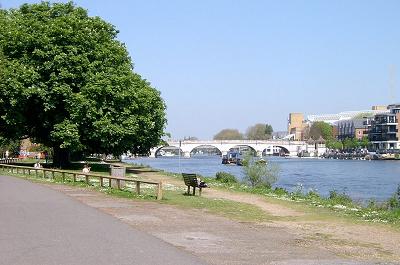Kingston-upon-Thames
From Hampton Court Bridge the river makes a giant loop to the south, sweeping back up again around the grounds of the Palace. The footpath becomes rather more grandiose than a simple towpath, and becomes a wide stoned pathway known as the Barge Walk. A very pleasant walk it is to, and I merrily stroll along with the parkland to my left and river flowing alongside on my right. Soon Kingston Bridge comes in sight. The grassy areas to the sides of the path are populated with people spending their lunch-hour sitting out in the spring sunshine.
 Kingston Bridge
Kingston Bridge
The day visitor to the area can make this last section from Hampton Court into a circular walk by following the A308 from Kingston Bridge back across the top of the loop to Hampton Court.
Kingston Bridge marks an end point of sorts, for I can now get rid of some baggage that has been with me since the dreaming spires of Oxford. At some point over the last couple of minutes I have passed the point where Jerome K Jerome set off with Harris and George (not to mention Montmorency the dog) on their adventure. “Our boat was waiting for us at Kingston, just below the bridge”. So he has gone, and another section of my journey ends. I am now in a “Jerome K Jerome-free zone".
Believe it or not I am only ten miles from central London according to the proverbial flying crow. However, the sweeping bends of the waterway through the capital require me to cover almost twice that distance before I reach Westminster Bridge.
Kingston was formed at the first crossing point of the Thames upstream of London Bridge. The town goes back to Roman times, and later there is a record of a great council being held her in 838 under the ruling of Egbert of Wessex.
The town really came into its own when it was chosen as the location for the coronation of seven Saxon Kings, starting with Edward the Elder in 900AD. The next four Saxon Kings were also crowned at Kingston, Athelstan (924), Edmund I (939), Edred (946) and Edwy (955). Two other Kings received their crowns at Kingston, Edward the Martyr (975) and Ethelred the Unready (991). They were all believed to be crowned using the Coronation Stone that now sits proudly outside the guildhall, with the names of the Kings carved around the base.
The origin of the town name is somewhat in dispute, so make up your own minds. One argument says that it is simply a derivative of King Stone from the coronations, and another says that it is from an earlier Saxon root being Kings Tun, meaning farmstead of the Kings. Both seemed very logical until I found another reference that it was called Kyningestun at the time of Egbert of Wessex in 838, which would dispel the coronation theory. If you are not confused already, then the good old Domesday Book will assist. In 1086 it recorded the town as Chingestone. However by 1200 King John granted a town charter and it was back to Kingston again.
Enough of the serious business lets get down to some quiz trivia. What was the name of the dog that used to sit by the wind-up gramophone on the famous “His Master’s Voice” advertisements? More to the point, what has it to do with Kingston? The answer is that “Nipper” the dog was buried in 1905 underneath what is now Lloyd’s Bank, and a commemorative plaque marks the spot for posterity.
Almost immediately after the bridge is Turk’s Pier. Surprisingly enough it has nothing to do with a native of the country, but denotes what must be one of the oldest business families in England still running what was basically the original business.
To say that the Turk family have been in the boat building and river transport business for a few generations is something of an understatement. They go way back to the days of the Crusades, building every sort of boat imaginable for use on the waterway including fishing boats, skiffs, pleasure craft and passenger ferries. There is a record in 1185 of a Turk building two galleys near to the Tower of London. Another Turk, also a shipwright was Lord Mayor of London in 1230. The present business was established in 1710 by Richard Turk, whose great-great- great grandson, also named Richard Turk, runs the business today.
On to Canbury Gardens, an attractive tree-lined riverside park maintained by the local council. It is hard to imagine that it is all artificial, being reclaimed from marshland by the dumping of building waste in the late 19th century. It is a very pleasant haven away from the bustling suburbs, and today is full of mums and tots and countless others enjoying a nice spring afternoon. The park was used as a filming location for Dr Who in 1973, but on this occasion no police box appeared to shatter the peace. At the end of the gardens stands “The Boaters Inn” with its wooden tables overlooking the river providing an ideal opportunity for a ham roll washed down with a couple of pints.
< Previous Page | Next Page >